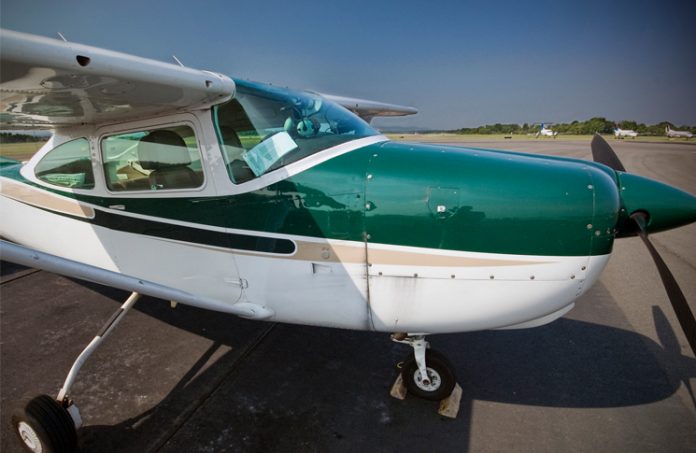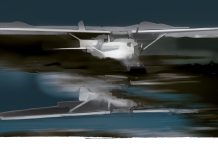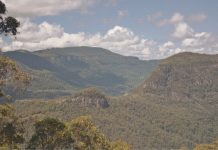Name withheld by request
I’ve held a VFR private pilot’s licence since 1988 and have around 1100 hours in command. Recently, I was involved in an incident, which could’ve ended in tragedy.
School holidays had just begun, and my 12-year-old son had convinced me that I should fly him to a friend’s farm near Minimay, in far western Victoria. I checked the weather and found a suitable time to fly, as the weather was forecast to deteriorate the next day.
The flight from Tyabb Victoria was uneventful in clear conditions and I landed my Cessna 182 RG on the property’s dirt strip. I stayed overnight and planned to get away in the morning, as there was an anticipated change later in the day.
The weather forecast in the morning predicted a north-westerly wind of 28 knots, at my intended cruising level of 5500 feet, this’d give me a nice tailwind. And there were some isolated thunderstorms, well south of my proposed route.
With some fresh farm produce onboard and leaving my son for a stay over, I took off, heading for Tyabb, into a stiff breeze and a darkening sky to the west. I then turned onto my south-east heading and continued climbing to 5500 feet.
I was in clear smooth flying conditions, so I set the autopilot, with a 190 knot ground speed (26 knots faster than the 182RG’s cruise speed).
My ground speed indicated the wind was significantly stronger than predicted, in the vicinity of 40 knots. I was whipping along.
My first waypoint, Balmoral, came up quickly and not long after I crossed the Victoria Range—the first part of the Grampians, which was some 2500 feet below me. In no time, I was flying over Victoria valley and fast approaching the second ridge line, the Serra range, when all hell broke loose.
BANG!! Arghh!! It felt my like my head had been rammed into a brick wall, Uhh! I was dazed … My headphones were hanging around my neck, which was aching and I had a metallic taste in my mouth—
I’d bitten heavily into my tongue. After a few moments, I came to my senses.
I was sure the aircraft was seriously damaged?
And the thought crossed my mind; I might have to deal with a crash.
But unbelievably, the incident had left the wings level, with a slightly nose down attitude and I was only a couple of hundred feet below my cruise altitude. I turned the auto pilot off and scanned the rest of the aircraft, incredibly it seemed intact. I then cautiously checked the control operations, which were normal, as was the engine.
I was sad, sore and sorry, but still able to fly. I considered landing at Hamilton, but once I had confirmed the plane was operating normally, I decided to continue to my destination.
So what had happened? Initially I thought of a bird-strike, or had I hit another plane? Clearly, my head had hit the roof and this was further confirmed by my bleeding tongue. And sadly my gifts from the farm were now a complete mess, with apples strewn about the cabin and broken eggs decorating the seats.
I contemplated my situation and deducted that I had hit some sort of extreme turbulence and somehow I had lost some 150–200 feet in a split second.
I knew something of mountain waves, and as a regular flyer over the Grampians, I have
always been cautious in my approach when tracking into a wind, which is at right angles to the mountain range.
I would always fly an oblique approach to allow for an easy retreat should I detect down drafts or severe turbulence. However, as I was flying with the wind, and at 5500 feet, I was thinking I was above the danger zone for this sort of turbulence.
As the pain and blood in my mouth subsided, I came to the conclusion I must have flown through a rotor, which was the result of mountain-wave turbulence activity.
Although I had my seatbelt on, I had loosened it a little and I’m 195cm tall, meaning my head’s pretty close to the cabin roof. I could’ve been knocked out and the outcome would’ve been much worse.
Having now read more on lee wave turbulence, mountain waves and rotors, this may have been an error.
In hindsight, all the conditions were right for these to be present over the Grampians on the day of my incident—a 25 knot-plus wind at right angles to the direction of the ranges, coupled with insufficient altitude to be positively clear of turbulence.
On reflection, when I became aware of the increased wind velocity, I should’ve either climbed to 7500 feet before flying over the Grampians to allow increased clearance from any turbulence activity, or better still, planned to fly via Dunkeld thereby avoiding the range.
The other thing which is easy to do, but often overlooked: keep your seatbelt done up tightly in any conditions.
The next day I had my LAME look over my aircraft which all checked out OK.






Great story. We’ve all been taught about headwinds and mountain waves, but obviously there’s a bit more to it. Back to the books to look into the risks associated with tailwinds over mountains! Thanks for sharing your story.
I fly gliders out of Benalla and very occasionally, in the middle of nowhere and in clear air, I have been hit by something which I can only likened to the aircraft being hit by a sledge hammer up or down. It corresponds to driving hard into a concrete step with a steel-wheeled trolley. The movement is usually very small, not like rotor where hundreds of feet may result. The metallic nature of the “bang” means aircraft structure can be tested suddenly. In seventeen years have only had two such encounters.
Many years ago I encountered severe, smooth sink to the east of the Tiers in Tasmania, with a westerly, and at high altitude (since I was towing a glider) which I could not out climb in a Maule M5. A turn of 30 degrees to the left took us out of the sink.
Flying a B58 Baron into a mine site in WA’s Murchison area, circling a CB which was pouring rain onto the landing strip. CB’s in WA are often isolated in otherwise perfectly clear weather. An anvil sitting atop a kilometre diameter stem of violence. I was circling the stem in clear sunny weather at what I thought was a safe distance waiting for it to move on. Then the aircraft shuddered in what was a brief but teeth rattling experience. I got a very clear message “don’t mess with me”. The ‘mountain wave’ story took me back thirty years.
On my second solo nav I had a similar experience. Just west of the Taggerty Range towards Glenburn Gap (Victoria) low power descending, and out of nowhere “kerbang” massive jolt, head hitting roof, arms thrown upward due to the forces. My immediate thought was what did I hit. I even looked back to see if it was another aircraft. Wings stayed level. All my items on the passenger seat lifted off and got thrown everywhere. Reported it to the flying school when I landed and I was told that it was mountain waves and it happens there depending on wind direction. Something I will remember.
October 1988 (Airlines Strike) I was flying a Cessna 182 from Townsville to Bankstown. Doing 120 kts IAS in an easterly direction over Narrow Neck (near Katoomba) I hit rotor waves. The forecast 60 kt Southerly had swung round to be a 60 kt easterly. At maximum rate of climb, I lost 100-150 ft, and just as suddenly had to try to descend to avoid breaking the 500 ft ceiling on VFR at the time.
It set off the ELB, which blotted out all comms, and RDF. SAR thought they were dealing with three crashes by the time I got them on the phone from Hoxton Park.
I still vividly remember the moment in the mid-1970s. I was in a Pilatus B4 metal sailplane, flying locally out of Currandooley near Bungendore, in totally clear smooth air. With no warning it felt as if the aircraft had run into something massive and just stopped. There was some sort of a bang from the metal structure. But no, we were flying on normally and there had been no obvious change of airspeed or height. No sign of a birdstrike. On the ground after landing, no damage at all.
The area occasionally experiences a “sea-breeze front” when cool SE wind from the coast 50NM away pushes inland under warm summer air. My best guess, then and now, is that I flew through a very abrupt front boundary. Don’t recall a significant wind change from launch to landing, though.
Pretty good guess Brian. I fly hang gliders from Gearies Gap from October through March each year. The sea breeze comes on like clockwork each day around 1900 Local, and can turn a 15KT Nor-wester into a 20KT Easterly within a minute. Lives have been lost near Bungendore during these changes. At altitude (3000′ plus over a 500′ ridge), the convergence can present as strong lift as high as 9000′ (this has been experienced inland as far as Gulgong). Nearer the ground, it presents as an extremely narrow band (<200m) of severe turbulence that tilts Eastward with altitude. I'm always wary of the onset of sea breezes when flying GA along the coast!
A long time ago coming back from a reef trip in a c208 Float plane, we struck a rotor. Weather was high overcast with 25 or 30kt southerlies at our altitude while coming past the northern side of one of the islands.
I understand completely when people say it’s like hitting something soild. It was very solid, violent and all over in 1.5sec. The pax were startled as we were and glad to be back on the ground that day